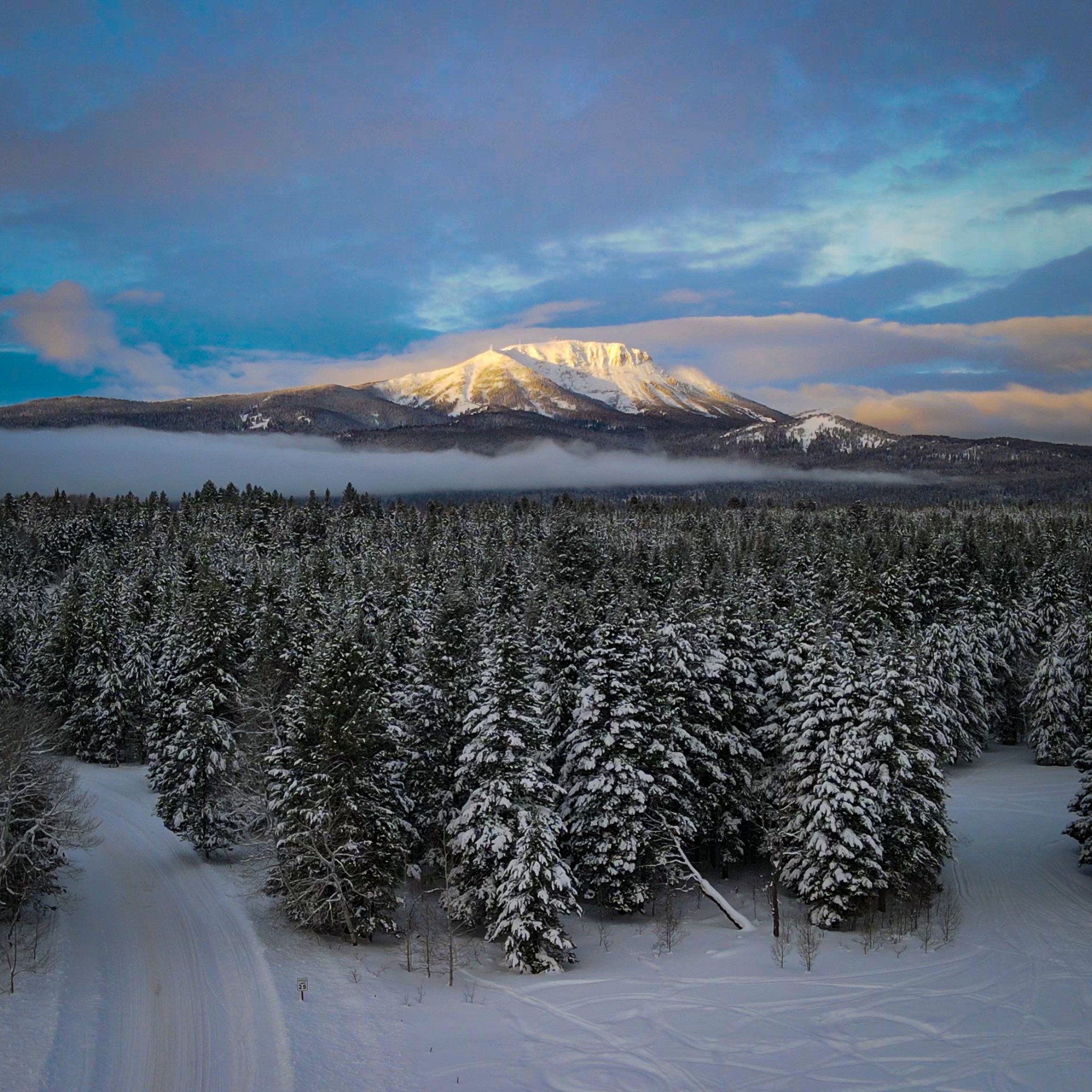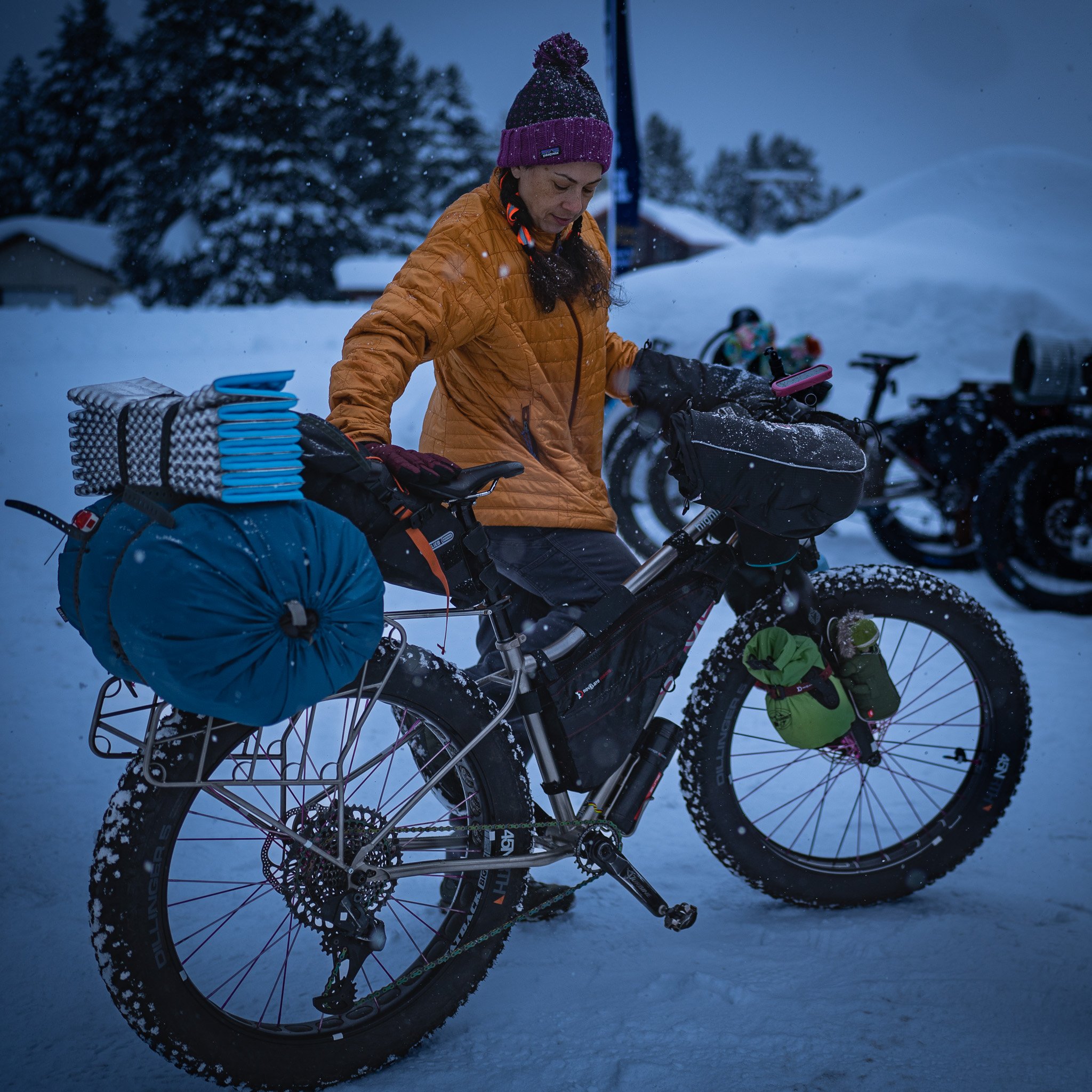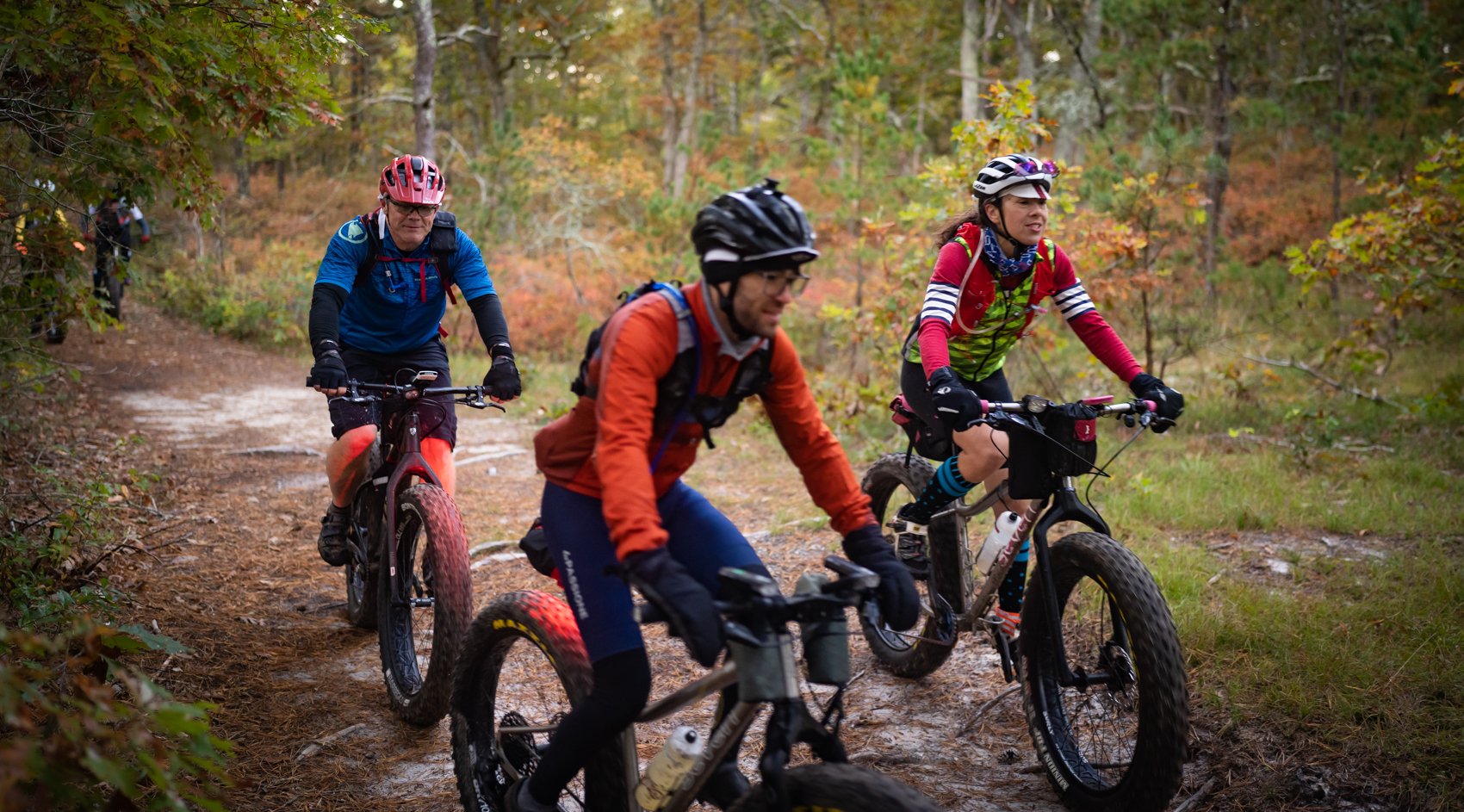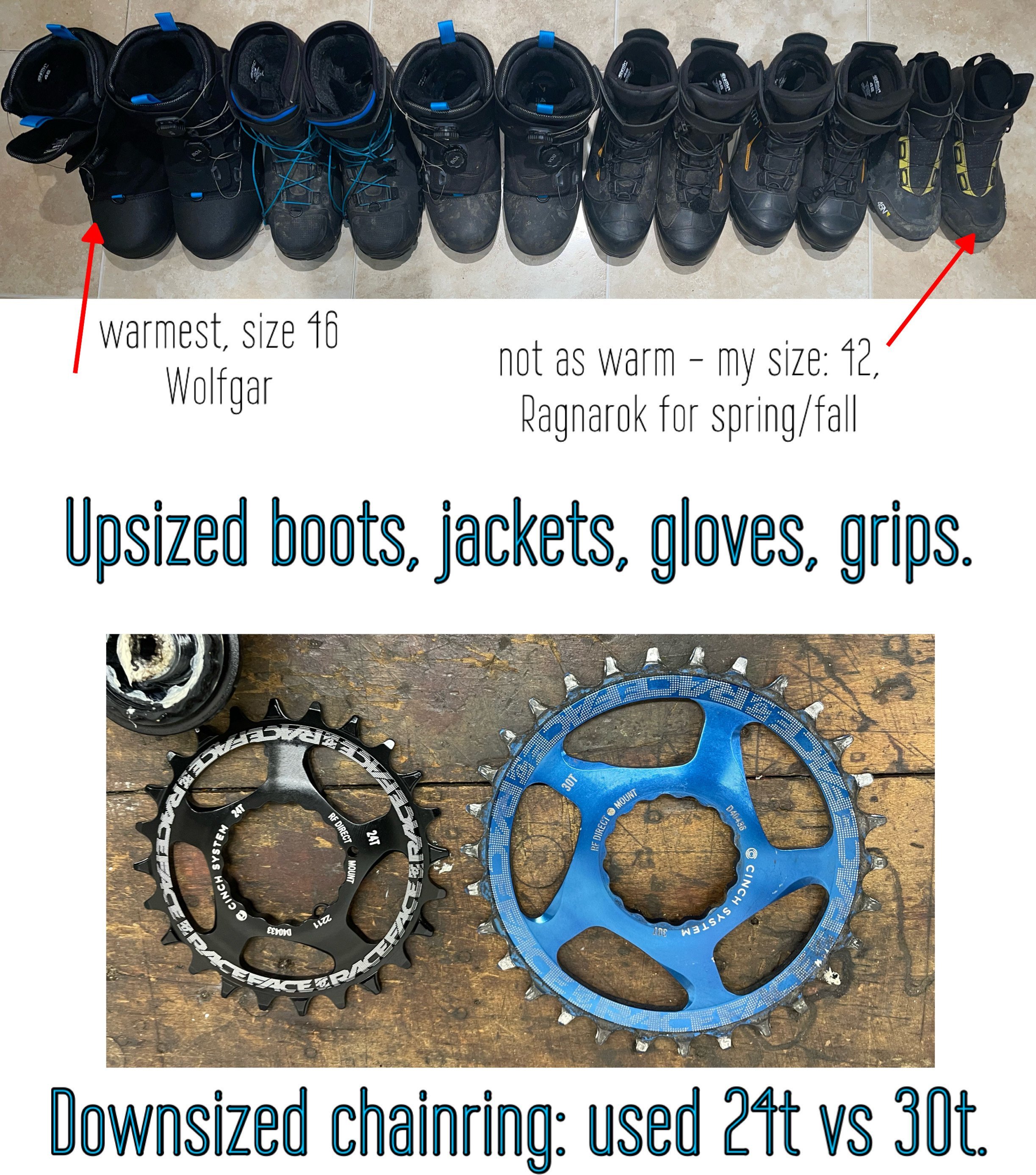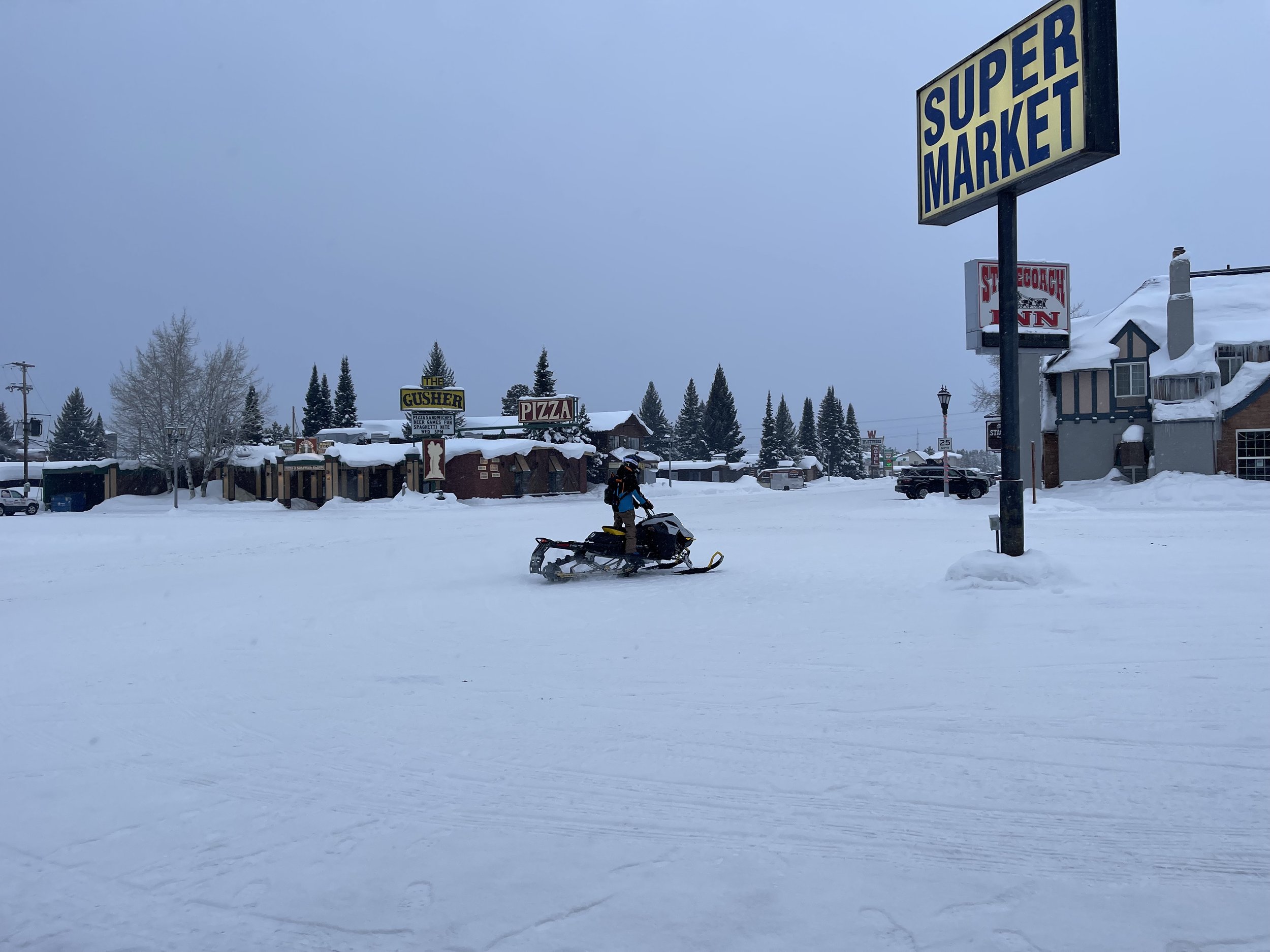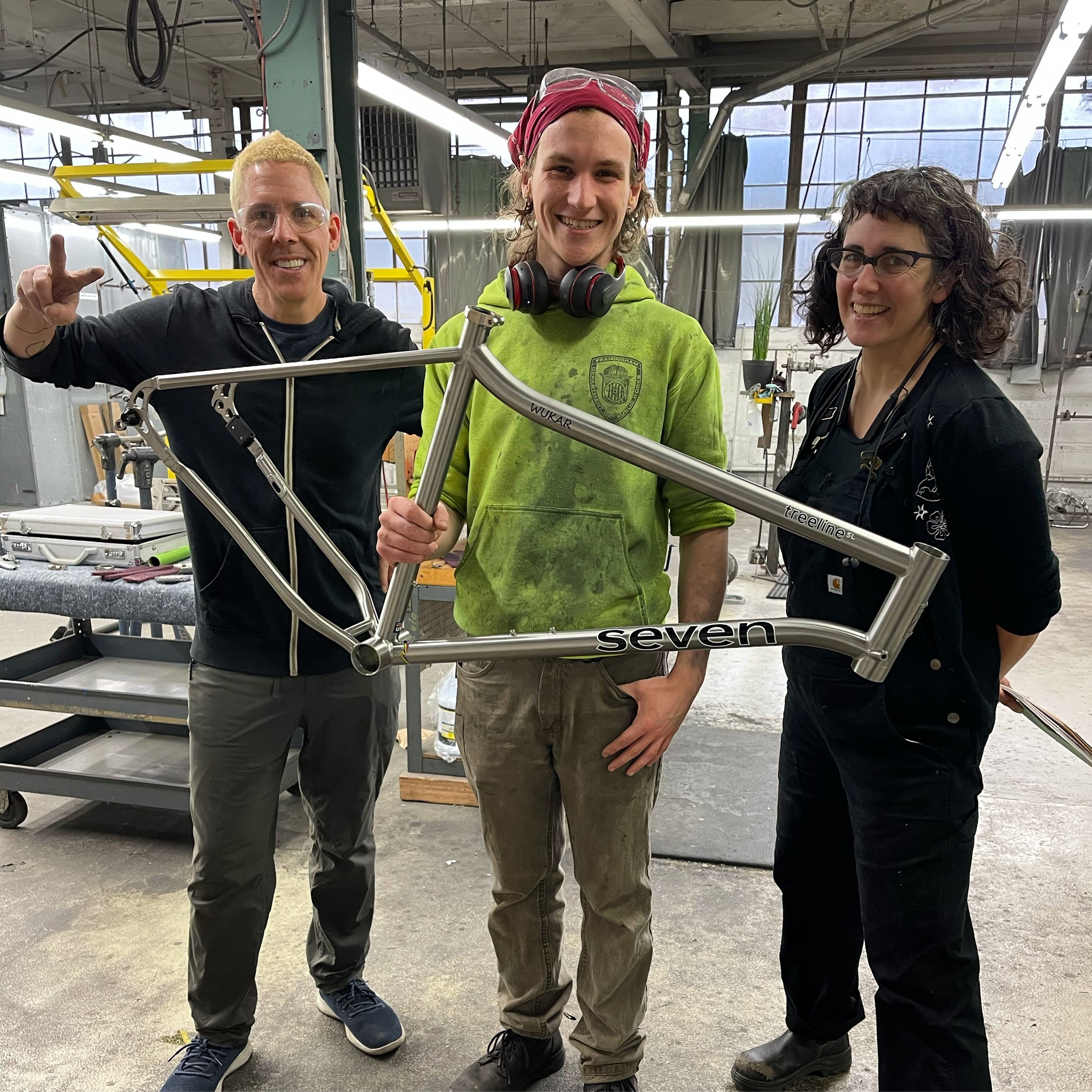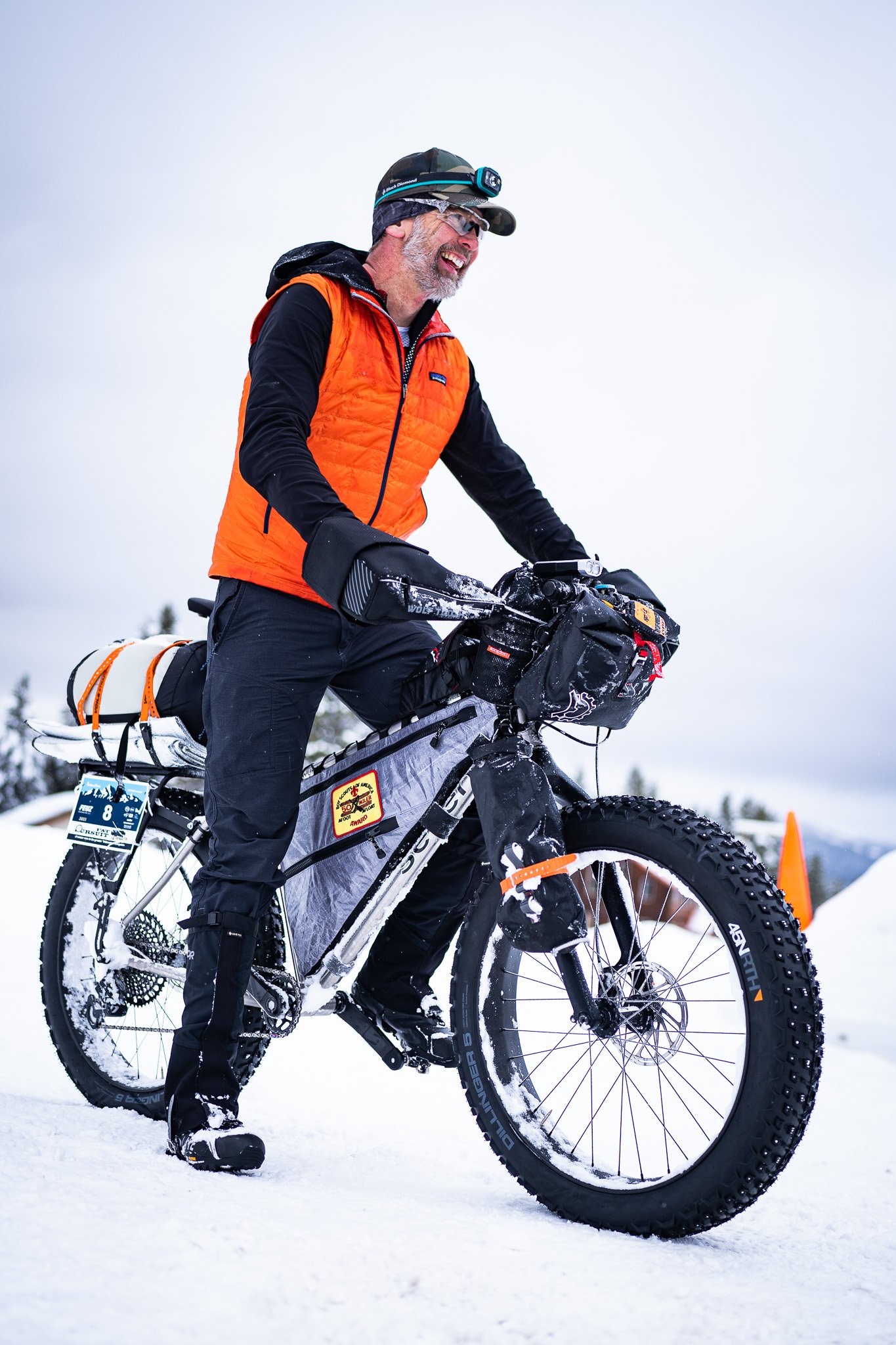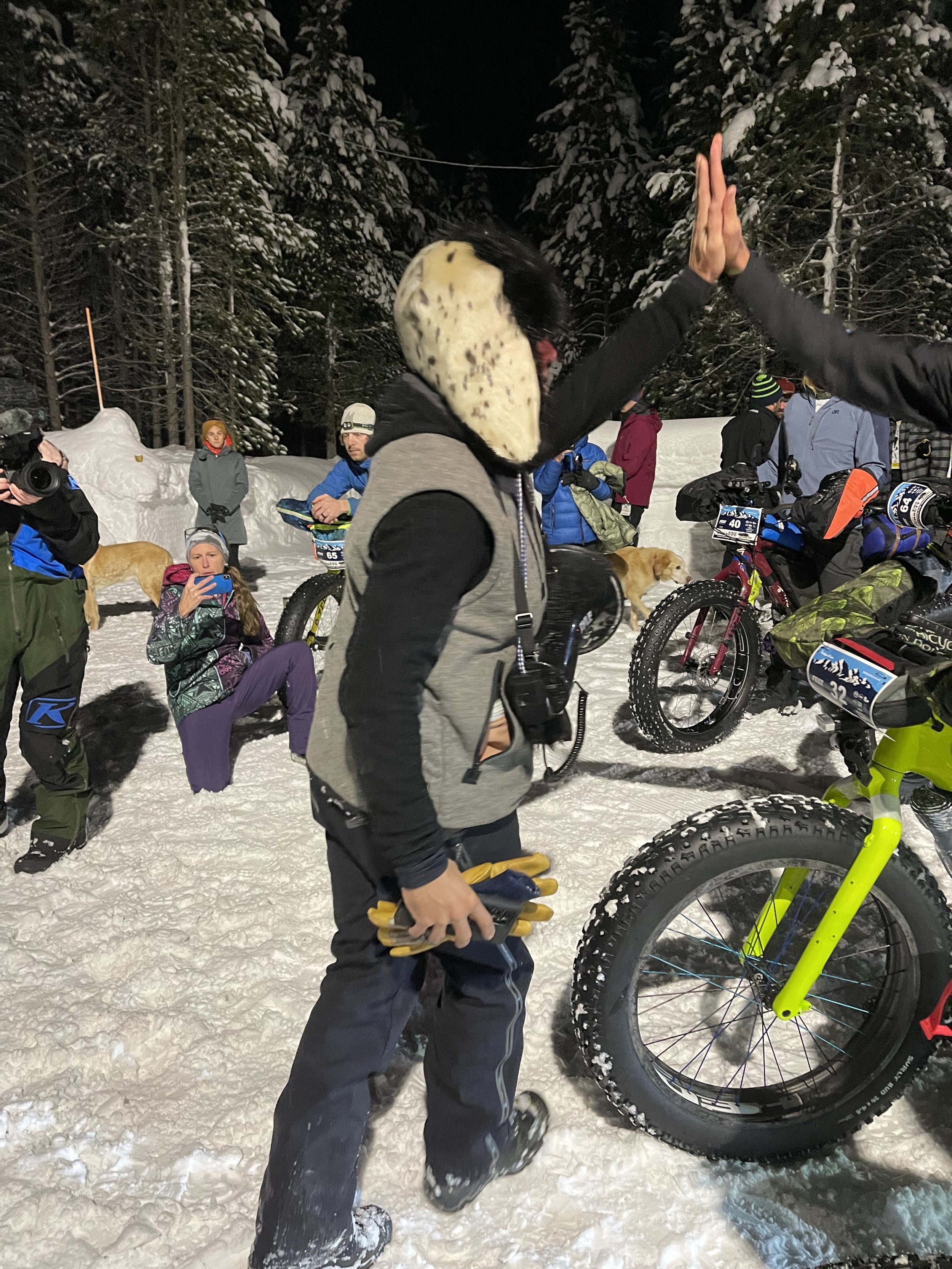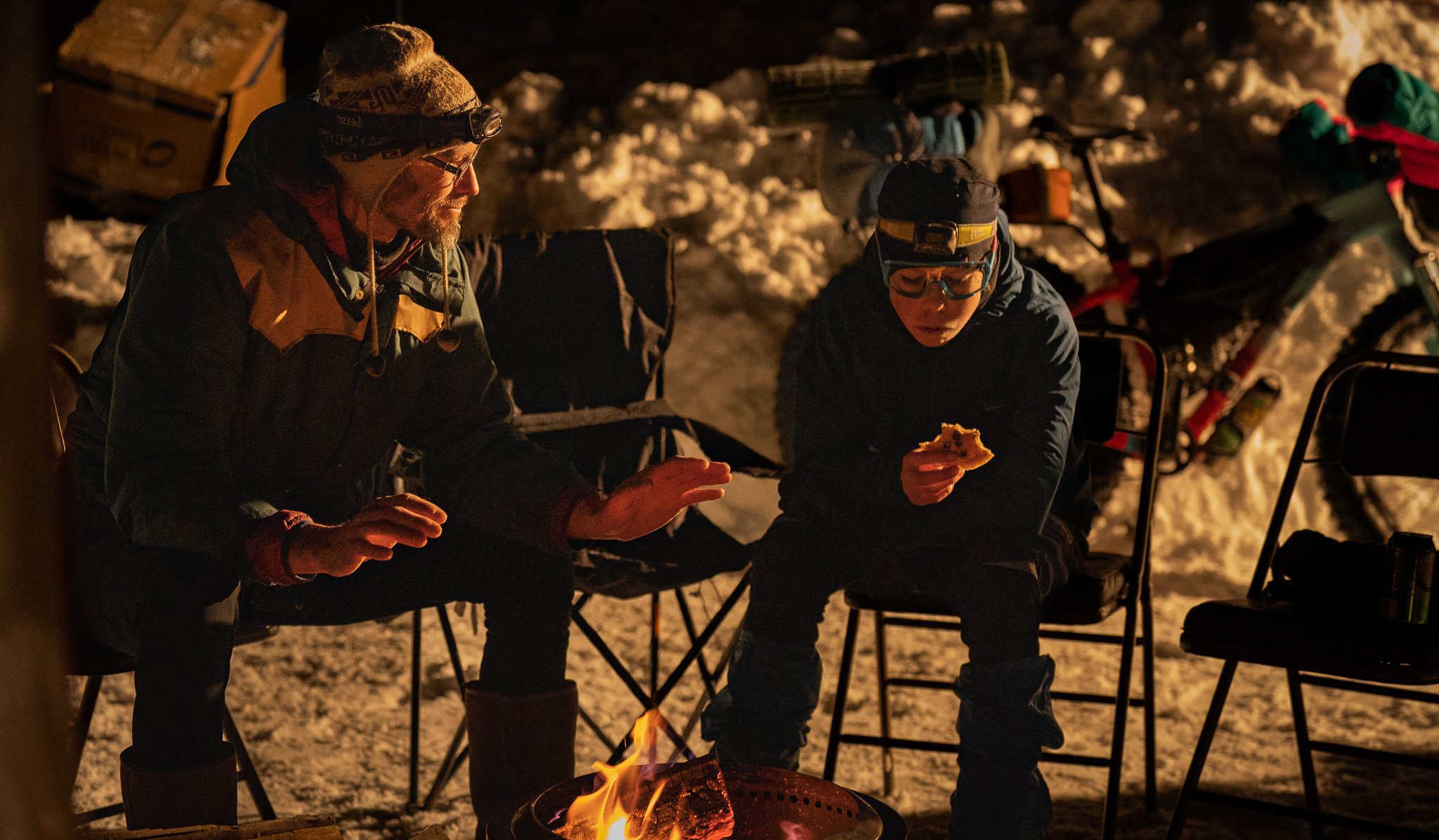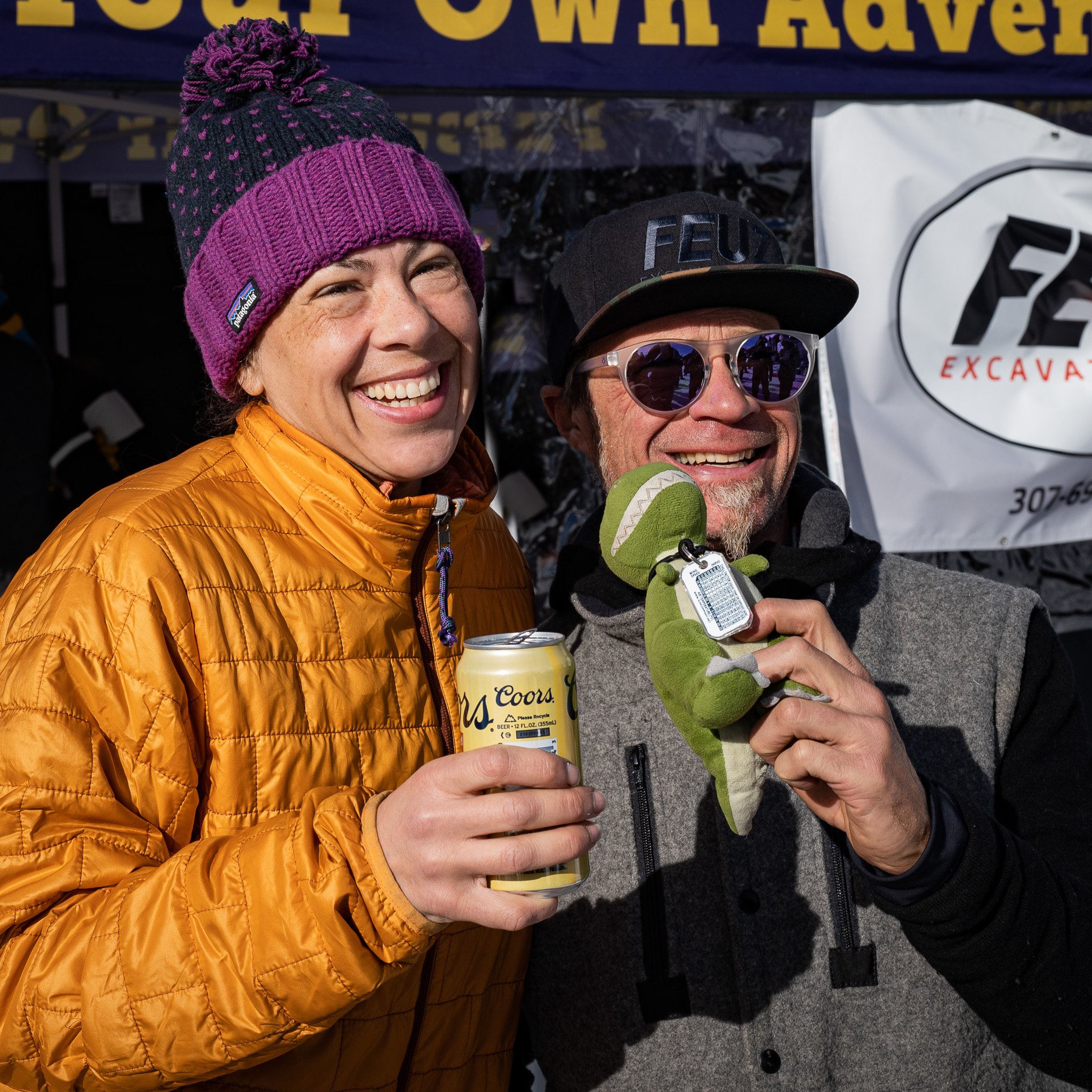Fat Pursuit is far more than an ultra endurance winter fat bike race in Idaho, in its 12th year. It’s a platform constructed by Jay Petervary to challenge everyone who arrives at the start line due to its length (119 miles), need to carry (and for most, use) sleeping gear, and be able to boil water to ensure survival in a snow-covered, harsh, remote winter environment. It draws people who love fat bike riding, who love big adventures, and those who want to stretch themselves, learn, and grow in the ways each person desires.
Racers at the start waiting for Jay to signal the start of what will be the longest, hardest race for many. Photo: Rob Vandermark.
45 hours on course leave a number of stories to be told. While I was determined to get to the finish line since I didn’t make it there 2 years ago, crossing the line didn’t come with the expected endorphin rush. I relished the experience and at no point did I wish it would be over, including at the finish. The small wins along the way have added up to a major victory and this is only a start, not a finish, to anything.
My first 200k Fat Pursuit was two years ago and a 33.5 hour race that ended at mile 75 when I didn’t feel I could continue. I’ve learned a lot since that race and having watched others finish at all hours that year, it was clear that it is possible for anyone who is properly prepared. Figuring out how to finish has been a journey of learning and digging in deep to discover exactly what it means to tap into mental strength. Having Fat Pursuit as a continual goal since taking on the 60km Covid edition of the race in 2021 has been a guiding light in my cycling life.
Around mile 77 coming out of checkpoint 2.
Fat Pursuit Workshop - a Game Changer
This year I made the best decision to attend the Fat Pursuit Workshop which was held Monday through Wednesday prior to Fat Pursuit which started Friday. This workshop had been recommended to me by serious athletes who have done nearly everything difficult that the sport offers. I have never been in such an environment where every single session was full of content, absolutely zero fluff (unless we were actually talking about the fill in a sleeping bag, ha), and hands-on. Fortunately, the temp got to -9 degrees Tuesday night when we had the opportunity to sleep under the stars somewhere far from home base. Such a treat. Besides having five instructors with deep knowledge of both Fat Pursuit and winter ultra endurance experience, 14 attendees all came from very different backgrounds with a lot of great knowledge and thoughtful questions.
Students and instructors on a ride Tuesday to get a little fresh air, boil water, and the scenery was outstanding! Photo by Jay Petervary.
Jay Petervary led the workshop, guided many of the conversations, but let each of the other instructors have the floor and share their expertise. Each session was deeply informative. Jay added what has worked for him that he’s learned over many years of testing, refining, racing, and teaching what works and why - and he started before anyone else was doing it. The workshop was a perfect balance of knowledge sharing and understanding why what works when and they encouraged questions. They explained the “whys” and what it means to “do your work.”
Jay Petervary, image from a video Jay took overlooking workshop students airing up all of our tires so we could feel various tire pressures and how those worked/didn’t on the snow.
I feel cold faster than most everyone and I’m afraid of being cold. My toes are cold as I’m writing this in my 70 degree home. FWIW: My toes didn’t get cold once during Fat Pursuit. I never want anyone to look at me and say anything about how I’m somehow tougher than others since the opposite is more likely true. To say I’m tough or special is simply an “out” for anyone who uses this as an excuse that I can do this but they cannot. Nothing we learned had anything to do with being tougher or stronger. Instruction focused on implementing systems to work for each of us as individuals. Turns out we’re not all that different. I can sleep comfortably at -9 degrees with the bivvy bag under my sleeping bag!
Photo by Perry Jewett, first night prepping camp and made some food. I learned it’s a good idea to eat before bivvying since calories = body heat!
The workshop started at 9am Monday and ended at 12pm on Wednesday, 2 days before Fat Pursuit. With sleeping outside being part of the workshop, it was continual instruction and practice for all of these hours. Focusing 100% without outside distraction means so much more learning and being fully present is a skill in itself.
Everyone had whatever fitness we already had, meaning that what we got out of the workshop was knowledge and tools for the mind. No one got stronger or more acclimatized to the cold in those 3 days. Knowledge is power. Knowledge is confidence. It all adds up to safety and more fun too.
Instructor Jason Hanson reviewed the stuff I would be bringing with me for Fat Pursuit and we talked through each piece of gear as to its usefulness and what should not make the trip. He has a great perspective from a normal person who chose to get into this winter endurance world even though he lives in Arizona!
One of the sessions dealt directly with the mental side of winter ultra racing. Jacob Hora, a 19-year-old ultra endurance athlete led this one. He has more endurance cycling experience and worldly perspective than most people 3x his age. This was a valuable session with a lot of interesting advice I’d not heard before and I used a lot of it during my Fat Pursuit race. I think people give the idea of mental strength a lot of lip service but don’t really take it to heart. I know I haven’t taken it seriously in the past. It’s one thing to think positive thoughts and another to completely believe those thoughts. One bit of advice they offered is to develop a mantra to use during the race.
The mantra that came to me early on in the race was “no excuses.” I hear a lot of excuses from people in the course of my work life and in leading group rides. I hope that after completing this, it’s proof that someone who has average fitness (I ride less than many of you reading this), but a sincere desire to take on a huge ride, can get into the right mindset to do the work, practice, practice, practice, and take it on!
The Race
The 60km race rollout is the same as the 200km, photo by Rob V.
The long Fat Pursuit course is 120 miles in length on wide snowmobile trails in the Yellowstone ecosystem and it’s a gorgeous route that offers a lot for the eyes to feast on. There is a 60km race for those who want a good taste of the event.
The route goes up a lot and when it’s going down, it's still often necessary to pedal to keep going. Snow conditions change a lot from hour to hour. Cold snow is fast. Warm, snowmobile-churned snow is usually a hike-a-bike. This year temps were in the 10-17 degree area most of the time and for only a few hours were ~27-28 degrees.
The start was at 7am, in pitch dark Island Park.
I was very deliberate to keep my heart rate low and in zone 2 (talking pace) for as much of the race as possible. This meant almost everyone was ahead right at the start. The effects of high altitude are far worse with an elevated heart rate. I had enough on my mind to manage without worrying about actually racing and trying to beat others. I am naturally competitive so I am thinking back now and wondering had I done this differently or that more efficiently, how would the results have turned out. These are thoughts I’ll use to fuel the next ultra effort, but I am not going to suggest that I could have been faster because that would have hurt me in other ways that could have led to not finishing.
The road leading over to Two Top is one of my favorite parts of the route. It’s beautiful and fun to ride. Usually there are others around on this road with whom to share the views and joy of being there.
Two Top mountain was raw with vicious winds and hardly any visibility. Snowmobile traffic was quite low the whole race, very pleasant! One snowmobiler stopped to tell me that “conditions are tricky” on Two Top before I got there. Nice to get this warning! I stopped, wrapped up my face, ate and drank, since this might not possible a few feet further up.
I was glad to get the Two Top experience since I’ve heard how windy and rough it can be, I wanted to see what that was all about. I was wondering what everyone else thought about that section. It’s a bit intimidating, but knowing others were out there in the same conditions was comforting.
Heading down Two Top, it didn’t take too long before getting nestled back into trees, the wind died down and it was a lovely day with perfect snow under the tires again.
This is when I met Ellen, the foot participant, who ended up taking the fastest time for everyone (men and women) in that category. I saw her quite often out there, keeping great time with very little mechanical advantage (sleds can sled down hills, but there were so few downhills on the course), otherwise, it’s walking/running for 119 miles. She was smiling the entire race.
The snow was perfect to ride. It was cold, fast, just fluffy enough to offer that addictive “first snow” feel. Of course, this area has many feet of snow on the ground at this point. The snow in this area is all dry powder.
Party at Checkpoint 1, Mile 28, ~2pm Friday
One of my favorite features of the course is that there’s an out and back to checkpoint 1 allowing riders heading in to CP1 and those headed out (hours ahead of those coming in often times) to see each other.
I like checkpoint 1 so much, I figured out how to spend something close to 2.5 hours there. Luckily, there was cell coverage so I could shoot off an “I’m okay” message to my parents who would be worried at this kind of a delay.
All participants can pack a 2-gallon bag full of food that the organizers take to the checkpoint so that everyone can get a selection of calories to take with them for the next stretch which is 50 miles. It’s a long stretch with a 24-hour cut-off time so it’s good to have a gazillion calories on the bike. I estimated I’d need 6,000 calories (more than I can eat). Sometimes it’s nice to have some variety since what one feels like eating can change. Somehow, my bag of food didn’t make it to this checkpoint. Thankfully, lots of nice people at the checkpoint (Mike, Joe, random people) donated their food to me. Billy is a mainstay volunteer of CP1 (I saw him there 2 years ago), he made sure I had all of the fried peanut butter and jelly sandwiches I needed (those things are magic), water, soup, etc. There was a good crew working this checkpoint, but Billy is who I’d remembered fondly from my last Fat Pursuit and he hustles to take care of every rider.
I was worried since my stomach can get touchy with food hours into a ride and Skratch High-Carb powder definitely works…except Skratch didn’t seem to be part of people’s diets out there. Oh well, time to learn new foods! I know I need to work on eating more every ride and getting my stomach acclimated to various foods. It’s one of the hundreds of skills that are important for this race. It’s entirely on me that my stomach is as sensitive as it is. What do bikepackers do? One certainly doesn’t find fancy food in gas stations. Fat Pursuit teaches us about survival and even allowing food bags is a kind thing for them to do though shouldn’t be necessary.
When hydration goes badly
I’d taken two hydration bladders with me, one filled with 2L of water with LMNT salt and a 3L with 2.5 liters of Skratch High-Carb powder in it to start the race. Each pack had its own hose. I like the idea of redundancy and the option to drink one or the other. Really early on in the race, both hoses froze so I rearranged them, got them tucked beneath my base layers and was able to thaw the one to my 3L pack. Once that ran out, I just moved the hose over to the 2L and then drank it. Both were gone by the time I got to CP1. I was proud of myself for listening to to my Garmin alarm: every 15 minutes take a drink. Altitude sickness comes with dehydration and I think my teeth get sensitive with dehydration as well. Dehydration is bad for everything in a race!
I filled both bladders with warm water, loaded my USWE hydration pack with both, then figured I’d take a moment in the heated tent prior to heading back out on my bike. I’d only been there a few moments when I felt my backside get warm. Then my legs… The 2L hydration pouch had failed out the bottom spilling all 2L of water all over me! I was wearing a short sleeve base layer, long sleeve base layer, full-zip fleece, wind jacket, bib shorts, and 45NRTH heavier shell pants. Every single thing I was wearing was soaked. Why did it fail? I have some theories. I’ll be doing some testing in the coming days to see what I learn. Obviously, this will be something I’ll be paranoid about for the rest of my life.
Fortunately, the heated tent is heated via propane and forceful hot jets. I stood there and dried out the pants, fleece, and jacket until everything was almost dry. I left my wool base layers and soaked chamois alone. I debated whether it was smart to ride into the night with wet chamois, but figured it would be more risky to try all of those miles without it since I always ride with bib shorts. It was a good call, it didn’t bother me. Had this happened without the heated tent, I can’t say I know what I would have done. I instantly regretted not bringing my rain pants and rain jacket. Those paired with my (still dry) wool long underwear could have allowed me to ride out the wet pants and give them time to dry without causing me problems.
Finally, I got back on the bike and on the way out of CP1. Only 1 more person was due to arrive to the checkpoint (who knew he was going to scratch) so I was the last rider on course. This did not send me into a panic, it was fine. I knew I had plenty of time until the cut offs. This kind of setback would have sent me into a panic had this been 2 years ago with the mindset and lack of perspective I had back then.
Riding into the night
I love night riding so much! Add snow and this is my absolute favorite kind of riding. Night focuses one’s attention, it’s impossible to get distracted by anything so it’s time to think, get into a zone, simply ride the bike. And that’s what I did. It was snowing some so the fastest-ever conditions were becoming not-quite-as-fast and this section is a long, steady climb, but still it felt great.
I found Emma and Brian, shown above, on the ride out of the checkpoint. We got to know each other in the Fat Pursuit workshop, and being from Seattle, pretty new to fat bike riding with heavy bikes, they had additional challenges. Emma is effervescent, has a beautiful Italian accent, and she was always, always positive, pleasant, and warm. We’d ridden together earlier Friday in the race as well. This blog post is dedicated to her since she enjoyed the blog I’d posted from my first Fat Pursuit attempt and the morning of this race, she told me she’d read it all again. I know people enjoy reading too-long race reports, but hearing that it affected someone means A LOT.
After a little while, I parted ways with them, and wished them well. I thought about them for the rest of my race, hoping they would keep going no matter what.
I was following a bike track laid down by a rider in front of me. I hoped to find this person to say thank you for laying it down since he was riding on the fastest part of the trail and it made it easier. I finally found him, it was Joe, fellow Fat Pursuit workshop alum. We rode together for quite awhile.
Finally Joe found a nice place to bivvy (above photo) and he was wanting some serious sleep. I bid him farewell and kept riding.
Since I’d had what I thought to be altitude issues at the last Fat Pursuit, I wanted to get to the top of the climb and then descend from there prior to sleeping. I was feeling good and was keeping a nice rhythm. Once in such a place, it’s not good to stop!
On this climb during the last Fat Pursuit, I’d gotten in a dark place and called Rob, devoted husband, who was out there taking photos and generally being there to support me wherever “there” was (it’s not possible for someone in a car to get close to the course until checkpoint 2). This time, I was good. Part of being good had to do with knowing the climb and what to expect. I’ve replayed that climb so many times in my head it’s a comfortable place for me now.
It’s nice to pass people who are asleep in their bivvies and tents along the way. Just seeing signs of life is beneficial. They’re hours ahead of me, yet I’m riding past them. Love this kind of a “race.” !!
There was a skier up ahead moving very well. Turns out it was Mike (of Nan and Mike - everyone out there knows them), our hosts! I’d seen Nan hours before and figured she was ~3 hours ahead of me. Mike had never skied more than 30 miles prior to Fat Pursuit. Nevermind that both Nan and Mike spent tons of energy hosting, throwing social gatherings, and helping others all the way up until late the night before Fat Pursuit. They are both incredible athletes and the nicest ever people. I chatted with Mike for a few and decided that’s where I’d get some sleep. He continued on. I learned later that Nan was sleeping really close by! Dani was really close, too, and she told me she’d seen me at my camp & I remember seeing her pass by after she described when she went through.
Sleeping in the snow, 18 degrees, 3:30am-ish
To bivvy is a verb. I have learned to put the bivvy sack under my sleeping bag as that’s perfectly warm enough and far easier without the feeling of suffocation that I’ve felt a number of times when sleeping inside the bivvy. The concept of bivvying has been nearly life changing for me since I learned to do it at the last Fat Pursuit. Sleep anywhere! Or just stay safe. Once zipped up in that little bag, it can be -50 degrees outside and you’re safe and warm inside. It’ll all be okay. It’s light and easy to manage. Take it and a sleeping bag and now the entire world of cycling is available to you, no humans or infrastructure required.
I camped in deep snow under a tree. It took a fair amount of work to drag the bike through the snow to get to the spot I liked. A bit of stomping around and the hole for the sleeping pad was big enough. Took off my boots and liners, it wasn’t that cold so I figured my feet would be fine without the extra layers and complication of pulling the liners out of the boots.
I set the phone alarm for 90 minutes of sleep for one complete sleep cycle, figuring it’d take about 30 seconds to doze off. After hitting snooze a couple of times, I woke up refreshed and ready for the day. I was low on water so I melted enough snow to fill my 3L pack and finished up by boiling water for a pourover. I had pre-ground the beans, but this was something I had been looking forward to for awhile!
There is snow everywhere, it looks cold outside and the mug is obviously cold, yet the coffee was as hot as boiling water in the double-walled mug. I very successfully burned by tongue. It still hurts as I write this. Weirdly though, I didn’t realize I’d burned my tongue until many hours later.
Of all of the things I expected to hurt post-race, it was not my tongue. Earlier Friday, I’d let my lips get chapped (maybe on Two Top with the howling winds?) So between my lips and tongue, they take the win for damaged body parts. Everything else is fine. My legs are tired (not that I’m using them) and nothing else hurts. The USWE hydration pack was super comfy where other running vests I’ve tried have been a little lighter but they have cut off circulation to my hands with 3+ liters of water and stuff in them.
Saturday Morning
While it didn’t feel like it took a long time to melt water and make coffee, time was moving by quickly. Time has a different meaning out there. If something is going to take 2 hours, no big deal. But it can take this much time to move 5 miles. The sun was coming up when I pulled out of camp ready to set off for the day.
It took a little while to settle into moving again. The rhythm I’d been in the previous night was no longer. I’d take a few pedal strokes and remember I needed to do something. Put Dematone on face. Check. Rearrange hydration hose. Check. EAT gosh darn it! It’s breakfast time!! Check. Oooh it’s pretty, take photos. Check.
It was only another 10-mile stretch to get to checkpoint 2 so I didn’t need all of that water I’d made, but it was comforting to be able to drink without worrying about running out so I drank a lot and enjoyed the ride to the second checkpoint where pancakes and coffee awaited. I loved this part of the route. It was beautiful and fun riding. This was the part of the ride at the last Fat Pursuit where I was hurting badly and I didn’t feel I could go on. It felt great to know that I would be passing through checkpoint 2 with no concern about continuing.
It snowed 3” or more overnight which meant riding was harder now. Slower riders get to go even slower! I heard that people behind me had a lot more bike pushing. The fluff on flat terrain was okay, no complaints here!
Breakfast at Checkpoint 2, Mi 77, 11am - Still morning!
Nicki (sp?) runs checkpoint 2 and Jacob, Fat Pursuit Workshop instructor, was helping out there with riders and making sure the CP2 workers weren’t going to overdose on pancakes or pizza. Gotta keep the volunteers fed and cared for too!
Rob was able to drive to this checkpoint so I got to see him there! Sounds like he and Jacob had a lot of time to chat and Rob was having a good time seeing the racers. It was fun to hear from him what was going on with everyone else. Apparently he was driving all over and taking photos of riders all night. People told me he slept less than I did.
CP2 near Harriman State Park was a terrific stop. Nicki is a super pro with pulling people’s food bags when she sees them coming in and making pancakes (I ate 3) and when I put Skratch in my water (now that I had my checkpoint 2 bag of food) & it had clumps, she took that hydration pack and massaged out every single clump with vigor. Jacob was offering up coffee and hot chocolate, so naturally, I had a mocha. Yum!
I saw two foot participants there, Ellen, who was still smiling and doing really well and (I think) Gavin was looking good and seemed to be having a great race. Ellen is unmissable with her smile and pink tape and sometimes pink coat.
Mental Game
The next many miles are a blur. The riding was good, harder than Friday with the soft, new snow. Even though the course looked flat in spots or even down, it felt like this whole stretch was some kind of climb. The last big climb of the race hit at mile 85 and the top was around mile 89. This climb was hard to ride so pushing the bike was nearly as fast and felt like a good choice much of it. Snowmobiles had messed up the surface as well so it’s slow snow.
This was a new part of the course that I haven’t seen before. I started hearing my breath loudly, and it felt a lot like what I’d experienced last Fat Pursuit, when I was sure I had altitude sickness.
I had a very serious conversation with myself. It’s a new part of the course, but there is nothing scary about it, it’s the same as the first part of the course. It’s fine. The top will come soon enough, it’s okay. It worked! My breathing changed back to how it’d been before, and I felt fine again. All that I had been experiencing was anxiety at the newness of the terrain. The sun was dropping in the sky and preparing for a second night is intimidating especially on a part of new-to-me-course.
An hour or two later, my friend from Boston who came out for Fat Pursuit, Brian, sent me a Garmin In-Reach message on this climb. It was a positive “you got this” message. I am new at the Garmin In-Reach but was able to figure out how to send a pre-programmed message back. I told him “I’m having a great time.” Which wasn’t exactly true at that moment. But I set my mind to find all of the ways in which I really was having a great time. This advice came straight from Jacob’s session at the FP workshop. A positive mental disposition is extremely important. It’s one thing to talk positively to self and a whole other to actually believe what you say to yourself. I worked on it until I believed what I was saying.
Made it to the top of the last climb!
The top of this climb was beautiful and the sun was setting. I saw Ellen for the last time here and was elated she got to see this same scene at the perfect time. The fast people didn’t get this sunset. Of course, they did get a pretty sunrise with nice conditions on Two Top, so there’s that.
The descent was slow with the powder tossing me off the bike from time to time. It was a tree-filled mountain, really nice. Soon it was pitch black, I was still surrounded by trees and enjoying the ride. Hallucinations of elves in the trees started in this area. They weren’t too numerous and they were all of friendly creatures Lord of the Rings style. Totally fine. This comes with sleep deprivation and is not frightening.
The course meandered along and then it goes around Island Park Reservoir and parallels a river for miles and many hours of pedaling. The trees disappear and then there’s nothing on both sides of the course. The moon was bright and it was snowing for awhile - yes, even with the bright moon! Sometimes there was thick fog, that was a bit eerie. Off to the right looked to be mountains in the distance.
I heard howling of either coyotes or wolves coming from the mountains. They were loud and many of them were out there. Then I had a hallucination of some creature that was in front of me, also right out of a fantasy book, that was ready to pounce. Jay would not put us on a course where animals will eat us I kept thinking. The creature ended up being snow and shadows from my light in the snow. It was fine! Continuing on.
Eventually, the trail turned into a snow-covered paved road that was passing by massive ranches. I was still in the middle of nowhere, but I was making progress to checkpoint 3 (an unmanned trailer).
How to make a long ride much longer
After getting on the paved road, my loooow tire pressure was making everything quite a bit slower than it needed to be. I considered the risk of adding air and causing problems. Something I shouldn’t do, I thought. But then, I succumbed to the allure of a faster ride and tried to add air into my back tire. The cold pump which had worked fine all day Friday for adding air, was too cold for the seals to work and it was useless. I flatted my tire in the process. Was it really that cold? Back-up time! I had CO2 cartridges and an inflator. I put the inflator next to the Hot Hands chemical hand warmers I’d had in my gloves to warm it up. Alas, I didn’t do it long enough, the CO2 air went everywhere except in the tire, the on/off valve simply didn’t work at all.
Rob had been waiting for me near checkpoint 3 to take a good night shot of me riding by. After waiting for me for awhile and wondering why my dot had stopped, he showed up on this dark road in the middle of nowhere in the rental vehicle. Naturally, I was alarmed at this stranger and got on the bike, riding it with the flat to not look like a damsel in distress. Finally, he said something and came over and I realized it was him. Thank goodness! He tried to offer good advice for the flat and to just ride it, it should be okay. I rode the bike slowly while warming the pump in my jacket and then tried adding air after a few minutes. The pump was back to life and I got a lot of air in there! Now I was flying!
…except the rear tire went flat again. Oh no! I spiraled to believing the tire had a big problem and it was going to be flat forever so I’d be walking the rest of the time. When I went to add air, I realized I hadn’t tightened the valve stem. Do I know better? Of course. This is what happens when the brain is tired.
So I added air yet again and the valve core came off with the pump. All of the air escaped. It takes a lot of pumps to get a fat tire full! Did it once again after tightening the valve core in there, and this time it held just fine. Whew! It wasn’t far to the trailer and CP 3 at this point so I didn’t have far enough to get warm again.
The trailer had big water containers and it was time for more water. I filled my bladder with about 3/4 L of what I thought was water but it came out milky yellow…hmmm. Bone broth! Then I found what was actually water and filled the rest of the bladder with that. I haven’t ever had bone broth on a ride and it’s my new favorite food. I don’t eat meat but I have no problem with this savory, nutrient-rich, creamy substance. Oh and it was warm!
Pulling out of the trailer, it felt like a cold, dark, still night. There’s no bivvying allowed after this since the last 11 miles of the race are called “a victory lap.” 11 miles sounds like nothing until one is sleep deprived and the body is beyond being out there for too long. My lights and everything with a battery started to suffer. It’s weird since the AAA lithium batteries aren’t supposed to be affected by sub zero temps, but my small flashing front light died. My headlamp did, too, but it was fine once I put it in my pocket and warmed it up. The rechargeable headlight showed signs of being close to the end of its life so I turned it to pulsing rather than low to save it as much as possible. It’s annoying to ride to a pulsing light! After it died ~45 minutes later, I rode by the light of the moon for awhile. It was bright enough to see just well enough. Finally, I pulled out another small backup light that I’d been warming in my jacket and put that on, set to pulsing since it was the very last one that I had. (I couldn’t remember where I stashed the last battery for my powerful headlight and was worried I had forgotten to bring it.)
The last section was really fun terrain and I liked it! I wish I could have been there in the daylight.
My derailleur stopped shifting. I was sure it was just too cold to work. Again, tired brain talking here. I had another full backup battery which I knew was with me and ready to go, but it didn’t occur to me to try it out. I just saw the snowy rear derailleur and decided it had frozen up. This is crazy to think since my bike worked absolutely fine at -9 degrees after a night of sleeping outside with me so of course at 6 to 9 degrees, the battery is going to be fine. So there I was stuck in my 42 tooth cog paired with the 26t chainring for the rest of the race on a course that had almost no climbs left. I really enjoy finishing races strong, coming in fast (er, relatively fast) so the super spinning I was doing didn’t cut it and I couldn’t speed to the finish line even though my legs told me they still had something left to give. How much? Will never know!
For those who are thinking I’m not so smart for having an electronic shifting bike, I saw plenty of people have issues with mechanical shifting bikes when things freeze in both the shifter and derailleur so all systems will have issues in the cold. I was just too tired to do the logical thing that I would have advised any group rider to do on a typical ride.
It was about two hours prior to the finish (43 hours in) that I started to feel pressure on my saddle, my shoulders got sore from the weight of the hydration pack, and knees felt a bit creaky. Going this long without any physical discomfort was a major win. Everything is much more dialed now than 2 years ago.
The finish (4:05am Sunday) was the best! Rob was there taking photos and there to welcome me back. I am so lucky he was there, his presence and support means the world.
Jay and a volunteer were there to proctor the water boil test and it looked like they had been out there for the entire night. Jay was there for every single finisher. And because he had the water boil at the end, that meant he interacted and had conversations with everyone who had energy left to chat. It was the best way to end the race and be able to say THANK YOU to Jay.
No excuses
Throughout the race, I was repeating and reviewing this mantra. I came up with others as well surrounding the concept of being prepared and never needing to end a ride if one brings the right stuff. No excuses. One makes one’s own luck. Things go wrong, it’s just a matter of managing whatever it is with a clear head, leaning on experience. Preparation and practice lead to efficiency and speed in all facets of this race or any endeavor one takes on.
There are countless reasons why getting to the starting line is impossible. Another thousand or so why getting to the finish line is impossible.
Crossing the finish is not a finish, it’s a mark in time. Photo above: water boil test just prior to the finish line. The learning of the past week will stay with me forever, as will the memories of the people, the conversations, the smiles, the hugs, and high fives. There is so much more to be learned, but the foundation is solidly in place to build on and I intend to attempt to impart what I have gained with everyone with whom I ride and interact.
I left my fear of cold behind. I learned how to talk myself out of dangerous breathing. I feel capable of taking on anything. I want to keep improving, be more efficient, do my work more quickly and proactively on the bike, constantly being on top of doing the right stuff at every moment on every ride.
Thank you
Thank yous can’t be properly expressed in words for the experiences I’ve had this past week. The instructors at Fat Pursuit camp: Perry Jewett, Jason Hanson, Jennifer Hanson, Jacob Hora, Jay Petervary were each fantastic. Jay for being the visionary behind it all and for being truly interested in growing each person who comes out to both the workshop and race. He does it for important reasons so far beyond “just” wanting to run a race. Tracey Petervary does a ton of organization and heavy lifting to make everything run smoothly while also managing all of the pre-race logistics. She is a force making so much happen that is not obvious. ALL of the volunteers, photo below, who support the racers at Fat Pursuit tirelessly and still have these smiles to share at the 12:00pm toast on Sunday.
Hosts Nan and Mike who made sure Rob and I had the full community experience the whole time and made sure we ate well and offered advice and guidance throughout. Friend Brian who came out from Boston for Fat Pursuit and who was so enthusiastic about it, that helped me stay on it where it came to training and proper prep prior to heading out to Idaho. Rob who supports me and the things I want to do in all of the ways, and his presence was good for other riders also.
Everyone who watched my dot and sent encouraging messages along in email, social media, txt, etc: your notes meant the world to me! I felt you watching me out there and it felt incredible to get “congrats” notes after I finished before I had even woken up in the morning after finishing!
The value of people near and far is highlighted in special ways with an event like Fat Pursuit. This is a world-class race that has reached “holiday week” status for many, and it’s run exceptionally well with riders’ safety a top priority. I recommend it to everyone, especially to those whose first reaction is to call it “crazy.”
Open the door to having Fat Pursuit as a goal for next year, and enjoy the journey that lies ahead.




















